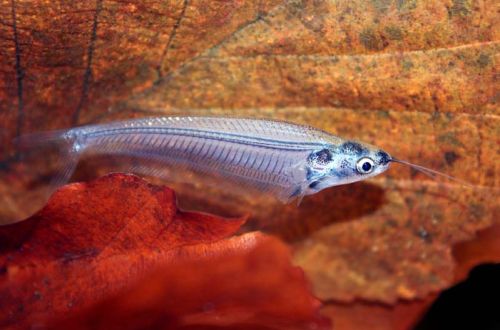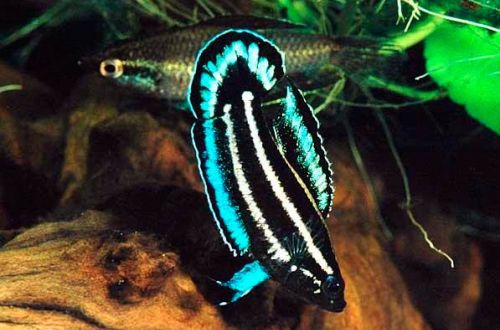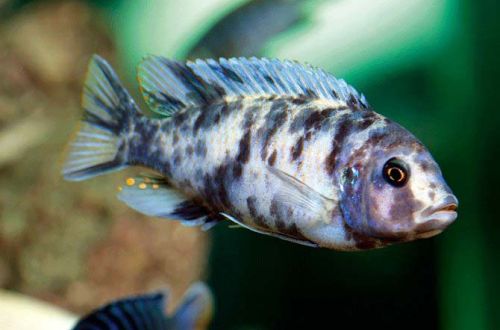
glass catfish
The glass catfish, scientific name Kryptopterus vitreolus, belongs to the Siluridae family. Perhaps the most unusual representative of catfish has such a transparent body that a fish skeleton is visible through it. Such an amazing evolutionary adaptation and relative ease of maintenance, along with a peaceful disposition, have determined the popularity of this species among aquarists around the world.

Another scientific name, Kryptopterus bicirrhis, is widely used in the literature. However, modern research has established that this is a different species, called the Indian bicuspid glass catfish. The true Glass catfish was singled out as a separate species only in 2013, so the erroneous scientific name is still used in numerous sources and publications.
Brief information:
- The volume of the aquarium – from 100 liters.
- Temperature – 20-26°C
- Value pH — 4.0–7.0
- Water hardness – 1–10 dGH
- Substrate type – any
- Lighting – preferably subdued
- Brackish water – no
- Water movement – light or moderate
- The size of the fish is 12–15 cm.
- Food – any variety of food
- Temperament – peaceful
- Keeping a group of at least 3-4 individuals
Habitat
It originates from the river systems of Southeast Asia, mainly in the territory of modern Thailand. They are found in rivers flowing into the Gulf of Thailand. Due to intraspecific confusion, the habitat area requires clarification. Prefers to stay in stagnant or slow moving water, usually quite muddy.
Description
An elongated high body with an unusually long anal fin that runs from head to tail. The main feature is a transparent body through which the spine and ribs are easily visible. On the head near the mouth are two long antennae.
Food
In nature, the Glass catfish is a small predator that feeds on zooplankton and invertebrates. In a home aquarium, it will be happy to accept all types of dry food (flakes, granules) in combination with frozen or live meat products (bloodworms, daphnia, grindal worms, brine shrimp, etc.). A varied diet is a must! Feed 2-3 times a day in the amount eaten in 5 minutes.
Maintenance and care
A small group of fish will feel comfortable in a tank from 100 liters. The design uses a large number of rooted and floating plants. The latter create additional shading for the aquarium, which is welcome. Any soil, selected based on the needs of plants, is not critical for fish, since they stay in the middle or upper layers of water.
Water conditions should be similar to those of natural habitat, i.e. soft (parameter dGH) slightly acidic (pH) water. The addition of a few dry fallen leaves will color the water in tea color, due to the dissolution of tannins, which is typical for weakly flowing swamps or wetlands of tropical rivers. Read more about the dH and pH parameters in the “Hydrochemical composition of water” section.
The minimum required set of equipment includes: a heater, an aerator, a filter (which, if possible, does not create a noticeable flow of water), a lighting system set to subdued light.
The maintenance of an aquarium with glass catfish comes down to daily feeding, periodic cleaning of the soil from organic waste (uneaten food residues, excrement) and replacing part of the water by 15–20%. The frequency depends on the number of inhabitants and the power of the filtration system, preferably once a week.
Behavior
Prefers flock content from 6 individuals. It is distinguished by calm behavior, peaceful and even modest. Active and/or aggressive neighbors or larger fish should be avoided. It gets along well with other peaceful small fish from Southeast Asia.
Breeding / breeding
There are no successful examples of glass catfish breeding in a home aquarium, at least the author was unable to find them. They are supplied to the retail network or wholesalers by breeders from Asia, where they are bred in special fish farms organized directly in the natural environment.
Fish diseases
Catfish is sensitive to the quality and composition of water, a noticeable change in parameters or deterioration in conditions will immediately affect your well-being. The susceptibility of fish to infection will become higher, which is fraught with various diseases. In a biologically mature aquarium with suitable conditions, health problems do not occur. Read more about symptoms and treatments in the Aquarium Fish Diseases section.





